Curved Dovetail Console Table

Curved Dovetail Console Table
Sapele and Glass 37″H x 70″W x 15″D
Some pieces that I design and build stand out for me. They stand out because they are born in a moment of inspiration and they continue to develop in unforeseen ways as they are built. Something just feels different from start to finish. This is one of those pieces. The story is that I was testing a new process that I have developed for delivering clamp pressure for bent laminations. This is one of the two methods that I use to bend wood. I needed to develop a new system for a few reasons. The biggest reason is the Circular Tree Bench that I am working on. The curves in that piece are enormous and there are many of them. There would be no way for me to manually tighten all of those clamps. The new system relies on an impact wrench to mechanically tighten the clamps.
Below you can see pictures of the curves in process. I made two just to make sure that everything was 100% in order. It was! I ended up with two gorgeous curved pieces of Sapele and that is when this piece quickly came into being.
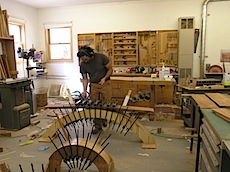
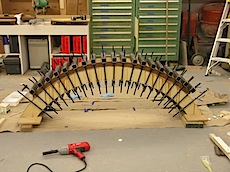
The curves immediately suggested structure to me and before I knew it I was building the table. The key to the piece was a short piece of glass that I had. I needed a way to create a wooden extension to tie everything together. I ended up creating a dovetail bridge that allowed me to seat the small piece of glass into the composition. Necessity forced this innovation and it is one of the reasons that I am so happy about this composition. Here is the table all roughed in.
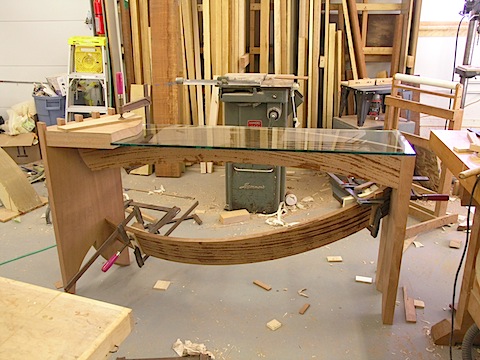
The dovetails are hand cut to a very high standard so that I can freely shape into them later. I treat them like I am creating a landscape. The process is all about spontaneity and I cut and evaluate over and over. The dovetails become a composition within a larger composition of the table. The structure is celebrated as decoration.
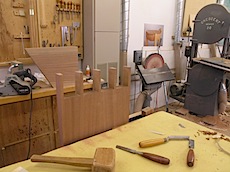
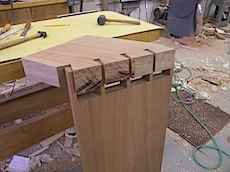
Once everything was blocked out I refine the composition with a series of cuts and facets. I use these to mellow some of the components and balance the composition. I strive for a balance even in this asymmetrical table.

I should mention that i have treated the Sapele with a chemical that emulates years of patina. The color comes from within and can not be achieved with pigmented dyes or stains.

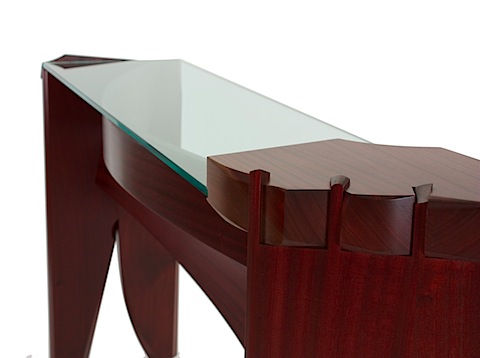
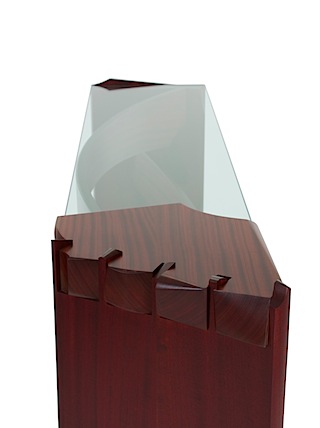

The Curved Dovetail Console Table can also be viewed in the portfolio section of my site. You will find a link for a 360° View which will allow you to rotate the piece.
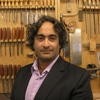 By Nico Yektai -
By Nico Yektai -New York based designer/maker Nico Yektai opened the doors to his Hamptons studio in 1995 after completing the MFA program at the School For American Craft at the Rochester Institute of Technology. The rigorous technical training complimented his background in Art History, which he studied, at Hobart College in Geneva NY. Yektai has synthesized this background into a singular style that has gained him national attention. Visit nicoyektai.com for more information
Bench #5 from Bench Series #2
The distinguishing features of the benches in this series is that they can be made to go indoors or out. The first version of this bench went outdoors. This one is designed to go indoors. Here they are side by side. You can see that they are very different and I am not just talking about the materials. My style allows for variation and these two benches illustrate that point. They are far from duplicates, far from being part of an edition. They are each a unique composition.

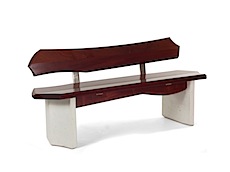
Sapele is a cousin of the Mahogany tree that is native to Affrica. I have been enjoying working with it as of late. The grain and the potential to be chemically aged, like this piece is very attractive to me. The chemical that i use fully reacts with tannins in Sapele and ages it to its maximum patina. Just like pressing fast forward! The natural depth that the grain has is maintained because the color comes from within the wood. A traditional stain or dye add pigment to achieve color resulting in muted depth to the grain.
The following series of pictures will illustrate how I approach both construction and composition. The cast concrete is poured into a pair of forms just visible in the second photo below (lower left). The first picture shows how the sapele stretchers butt up against the concert legs. I designed the joint to be very strong and to relate to traditional construction techniques. The seat and the back in the second photo are about to get cut, shaped and faceted into their final form. At this point the piece could go in an unlimited number of directions. This is the flexibility of the way I approach my material.
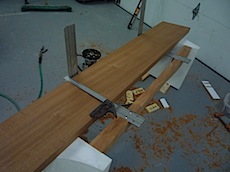
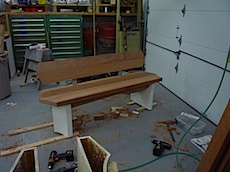
The first movement often sets the process in motion. In this case the first move was shaping the stretcher below the seat. This threw the composition out of balance and I reacted to it with a movement under the left side of the seat back.

This process continues as I move around the piece. There are moments where I do not want a big bold cut. In those situations I can use the facet. Light reflects differently and i can use them to balance the composition.

I should mention something about the seat back. The bench has evolved with comfort in mind. The back now has a positive curve for lumbar support. Combine this with the curved seat pan and this is an amazing comfortable bench.


I always sign and date my work.

Bench #5 from Bench Series #2
Sapele, White Cast Concrete and Stainless Steel, 29H x 67W x 18D
I picture this bench finding a home in need of a piece of furniture to anchor a wall. An entrance way would be perfect. The bench could also hold its own in the center of a room due to the sculptural view from the back.
Bench #5 can also be viewed on this page with the added feature of a 360° View
 By Nico Yektai -
By Nico Yektai -New York based designer/maker Nico Yektai opened the doors to his Hamptons studio in 1995 after completing the MFA program at the School For American Craft at the Rochester Institute of Technology. The rigorous technical training complimented his background in Art History, which he studied, at Hobart College in Geneva NY. Yektai has synthesized this background into a singular style that has gained him national attention. Visit nicoyektai.com for more information
Tripoli Gallery
I dropped of a bench at Tripoli Gallery of Contemporary Art in Southampton NY. Trip has been renovating the gallery and wants to have some functional art in place of the previous furnishings. I was happy to oblige and it will be nice to have work in the village again! Plus my brother Darius shows with Trip. Come to think of it the last time I showed with Darius he dropped a light on a bench of mine.
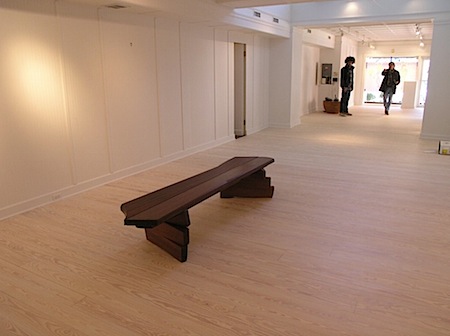
Trip wants to go for a more flexible layout to the gallery so he will be needing something to replace the built in counter/desk that he took out. I offered to build a coffee table that could be at the heart of that new work station/lounge area. The piece will go just about where he is standing in the picture above. This is going to be fun! I had similar arrangement in Southampton once before with Clarke Fine Art. Off to get started before I am off to Smithsonian
 By Nico Yektai -
By Nico Yektai -New York based designer/maker Nico Yektai opened the doors to his Hamptons studio in 1995 after completing the MFA program at the School For American Craft at the Rochester Institute of Technology. The rigorous technical training complimented his background in Art History, which he studied, at Hobart College in Geneva NY. Yektai has synthesized this background into a singular style that has gained him national attention. Visit nicoyektai.com for more information